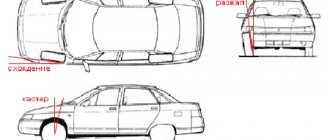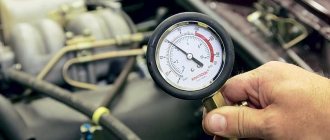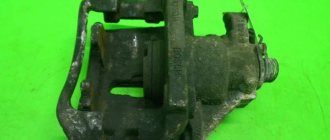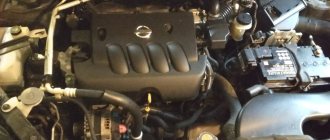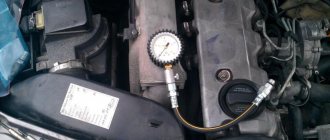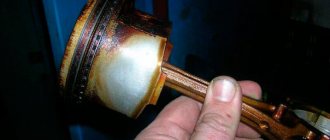Compression - what is it and what should it be?
Compression is a measure of the maximum pressure in the combustion chamber that the piston can create when it reaches TDC during the compression stroke.
Measuring this indicator gives an idea of the tightness of the chamber, which in turn depends on the condition of a number of elements - the piston and compression rings, valves with seats, head gasket, and the installed thermal gap in the timing belt.
Since the compression measurement technology itself is simple, and the data obtained as a result of its implementation makes it possible to estimate the remaining life of the power plant and identify a number of malfunctions, this diagnostic operation is quite common.
Although car power plants have a common design principle, they are structurally different, which also affects compression indicators.
Each engine has its own specific maximum pressure values in the combustion chambers, which must be indicated in the technical specifications. documentation for the car.
For example, for a VAZ-2106 a compression of 11 kgf/cm2 is considered normal, but for a VAZ-2110 this figure is already 13 kgf/cm2.
Note that when measuring, it is not necessary that the device should show values that correspond to the norm. As engine components wear, compression readings will drop.
Moreover, if they drop below a certain value, this will be a signal of extreme wear of the power plant’s CPG, and the need for major repairs.
Some variation in readings between cylinders is also allowed. However, it should not exceed 1 kgf/cm. sq.
That is, if measurements on a VAZ-2115 showed that the compression in the cylinders was 12 kgf in the 1st, 11 kgf in the 2nd, 12 kgf in the 3rd, 12 kgf in the 4th, then the power plant of the car will be considered to be in working order.
Read more about compression and compression ratio of a diesel engine.
Increased compression - increased power: the second fairy tale
Not certainly in that way. Compression can be increased in two ways - increasing the compression ratio or reducing leaks from the combustion chamber. Let's see what happens in each case: we have a stand at our disposal.
First, let's reduce the volume of the compression chamber. The easiest way to do this is to grind the bottom plane of the cylinder head. The base engine of the “eleventh” VAZ has a cylinder displacement of slightly more than 370 cubic meters. With a standard compression ratio of 9.8, the volume of the compression chamber will be 42.6 cm³. You can calculate that by removing 2 mm from the seating surface of the cylinder head, we reduce the volume of the compression chamber by 5.1 cm³. The new compression ratio will be 11 units, that is, 1.2 higher than that of the base engine. Now, just out of interest, let's remove another 2 mm. The compression ratio increases to 12.6. In the textbook we find the required formula and get: the thermal efficiency of the piston engine cycle should theoretically increase in the first case by at least 4%, in the second - by 9%. Great!
Now we put these heads on the bench motor and take the torque characteristics. The reduction in fuel consumption is significantly less than the theory promised - by 2.5% in the first case and by 4.5% in the second. Moreover, the effect is more pronounced in the zone of low loads. The increase in power is even less: 2–3% at most, and in the low and medium speed zone. And at high levels there is no effect...
Everything is clear: with an increase in the compression ratio, the pressure in the cylinder increases sharply, this increase provokes detonation, the corresponding sensor catches it and shifts the ignition timing back. Consequently, the power drops. And therefore the theoretical effect is significantly reduced. But the exhaust temperatures increase, which means that the risk of burning valves and pistons with such an engine is much higher.
The second method is to reduce leaks. Let's start from the opposite: let's compare what will happen to the torque characteristic if we replace the rings so that the gaps in them become, say, twice as large.
Done. For a new engine everything is fine, compression is 13.2…13.4 bar for all cylinders. For one damaged by rings with large gaps - 10.8...11.1. What did the power measurements show? In the low speed zone, the power of the damaged motor dropped slightly, but when we reached 2500 rpm, the torque curves almost merged. This is because leaks from the combustion chamber into the crankcase, which should reduce power, are noticeable only at low speeds, and at high speeds their mass per cycle drops sharply, because with a decrease in cycle time and an increase in crankshaft speed, the time for leakage also decreases .
Compression increased sharply, but power did not. Along with compression, detonation arose, and the ignition timing had to be shifted back. And it affects the power more.
Reasons for a drop in compression in one cylinder
It also happens that a pressure drop occurs in one of the cylinders, and significantly (in some cases, compression can drop to 3-4 kgf/cm2).
And such diagnostic results are a reason to worry, because there are malfunctions in the power plant.
The reasons for a drop in compression in one of the cylinders above normal may be:
- COMPRESSION RINGS. These elements play one of the most important roles, since their task is to ensure tightness in the piston-cylinder pair. If the rings are damaged (burst) or stuck, they will begin to leak working gases into the sub-piston space, which is why a significant drop in compression occurs;
- VALVES. Through these elements, the components of the combustible mixture are admitted and exhaust gases are removed. But during the compression stroke, the valves are closed, which seals the combustion chamber. But if, due to a violation of the combustion processes, the edge of the valve plate and seat are burnt, or the thermal gap is broken, and it turns out to be slightly pressed, then the tightness of the chamber is not maintained, which affects the compression;
- PISTON. This element is rarely to blame for a drop in pressure in the cylinder, but there are still situations when the reason lies precisely in it. As a result of the same process changes, the piston crown may burn out. This usually happens due to a violation of the ignition angle. And if the piston burns out, then there will be no tightness;
- BLOCK HEAD. Although rare, it does happen that cracks and other defects appear in the combustion chamber, affecting the loss of compression. Also, the head can cause a loss of pressure in some cylinder if it fails due to overheating. Due to changes in geometry, the head in some places simply does not fit tightly to the gasket. Even a simple insufficient tightening of the cylinder head bolts can affect compression;
- cylinder head gasket. Due to internal defects or overheating, a breakdown of this gasket may occur. As a result, one of the cylinders is connected to a channel of the cooling or lubrication system, another cylinder (in this case, a strong drop in compression is observed in two cylinders), and the breakdown can also lead out of the engine. Read more about the signs of a broken cylinder head lining.
Also read why the car engine does not pull.
Does compression always indicate engine health?
Before we consider the signs and reasons why there is no compression in one or more cylinders, we will analyze whether this parameter affects the performance of the power unit. If the pressure in the lubrication system of a 406 or other engine is below normal, in practice this indicates wear of the internal combustion engine components. But it is not always the case. When mating the piston rings with the plane of the cylinders, it is the lubricating fluid that collects on the walls of the engine that plays an important role. Thanks to engine oil, the interface of the components is sealed.
When not all of the air-fuel mixture burns in the power unit, this leads to an increase in fuel consumption. If spark plugs fail, fuel will wash motor fluid from the walls of the engine, because gasoline is a good solvent. And if there is no lubricant in the system, there will be nothing to seal the combustion chamber with. Accordingly, because of this, air under pressure will begin to enter the crankcase of the power unit. This leads to the fact that in a 4-6- and 8-cylinder internal combustion engine, compression will drop sharply and disappear.
If its level is normal or higher than necessary, this will cause increased consumption of motor fluid. Due to increased compression, the rings wear out faster. And the gaps formed as a result of wear will begin to be sealed with lubricant, which is in abundance. This problem requires prompt repair. But in fact, compression does not show such a malfunction.
You will learn how to correctly perform the diagnostic procedure from the video published by the AssistanceTV channel.
What and how to measure compression?
As noted above, measuring compression is a simple operation, and it can easily be performed in a garage.
But for this you need a special measuring device - a compression meter.
In fact, this is a regular pressure gauge, equipped with a check valve, as well as an extension cord for ease of diagnostics (the kit may also include attachments for working with different power plants).
In addition to this, the device will also require a spark plug wrench. You won’t be able to diagnose it yourself, so you also need an assistant.
Let's look at how compression measurements are made using the example of a VAZ Kalina car.
The sequence of actions for diagnostics is as follows:
- Warm up the engine to operating temperature;
- We relieve the pressure in the fuel rail (pull out the fuel pump fuse, and then start the engine again so that it produces the remaining gasoline in the rail);
- We remove the tips of the spark plugs, as well as from the ignition module;
- We unscrew all the spark plugs;
- We install a compression gauge in the spark plug hole of the cylinder;
- We ask the assistant to press the gas pedal all the way (this will ensure maximum air supply to the cylinder, which will make the readings more accurate), and then turn on the starter. In this case, to obtain correct data, it is necessary that all 4 strokes have passed in the cylinder being measured, that is, you need to turn the crankshaft at least 2 turns;
- Since the compression meter has a check valve, the device will record the maximum pressure value in the cylinder;
- We write down or remember the obtained pressure value, reset the readings and move on to the next cylinder.
After taking measurements in all cylinders, we compare the data. If the difference in readings does not exceed 1 kgf/cm2, put the spark plugs in place and continue operating the car.
And it’s not a fairy tale at all.
So what does compression do? For a lot! The main thing is the starting properties of the motor, especially at low temperatures.
This primarily applies to diesel engines, where the pressure and temperature at the end of compression determine whether the fuel in the cylinder will ignite or not. But gasoline engines in a cold state are also sensitive to changes in compression: it affects the volatility of the fuel, which, during a cold start, should only theoretically evaporate on the way to the cylinder. But in reality, it gets there in the form of non-flammable liquid drops.
Reduced compression increases crankcase gas pressure. In this case, a larger volume of oil vapor flies through the ventilation system to the engine inlet. This is bad: toxicity increases, and the rate of combustion chamber contamination increases sharply.
Uneven compression across the cylinders causes engine vibrations, especially noticeable at idle and at low speeds. And this, in turn, harms both the transmission and the engine suspension. And to the driver himself.
In short, the role of compression as a diagnostic sign, largely characterizing the condition of the engine, is very great. And our “fairy tales” in no way call for giving up on her - on the contrary! But the desire for an unbridled increase in it in search of additional “horses” is generally futile.
How to determine why the compression in the cylinder has dropped?
If it is determined that in one of the cylinders the compression is below normal, it is necessary to determine what exactly caused the problem.
To more accurately determine why the pressure in the cylinder dropped, you should carry out several simple procedures:
- Pour 10-15 g into the cylinder with reduced compression. engine oil, then measure again. If the indicators have improved, it means that the reason for the fall lies in the rings (they are stuck or one of them has burst);
- Remove the valve cover and check the valve clearances on the required cylinder;
- Carefully inspect the engine at the junction of the head and the block. If there is a gasket breakdown leading outward, oil leaks will be visible;
- Pull out the dipstick and assess the condition of the oil. If it is very blackened and a burning smell is clearly visible, then this may indicate a breakdown of the gasket, in which the cylinder is connected to the oil channel;
- Assemble the engine and start it. Then you should inspect the expansion tank of the cooling system. If escaping air bubbles are visible in it, this will signal the connection of the cylinder with the channel of the cooling system. Additionally, you can put your hand on the exhaust pipe while the engine is running. If small sweet-tasting drops remain on the palm, this will indicate that coolant has entered the cylinder, that is, there is a breakdown.
If all the procedures carried out did not produce results, that is, after filling the oil, the compression did not increase, the thermal clearances are normal and there are no prerequisites for a breakdown of the cylinder head gasket, then the reason lies in the piston, valves or cylinder head.
But to make sure of this, you will have to remove the block head.
Repair
As I wrote above, it’s really difficult to make repairs yourself. Unless, of course, you have a blown gasket, it’s possible to repair it, but again, it’s not so easy. How to replace a short video.
Diagnostics are carried out with the cylinder head removed - here the malfunction can be determined 100%. You are unlikely to do it yourself; contact specialists at a service station, or people who understand.
I think my article was useful to you - read our AUTOBLOG.
Similar news
- Fuel supply systems. Let's look at the petrol options. Required…
- Why does the turbine drive oil? To the intercooler (also to the intake manifold...
- Check Engine. What does it mean and why does it light up?
Add a comment Cancel reply
Debugg
Eliminating the causes of a drop in compression in one of the cylinders directly depends on what was to blame for its occurrence.
Most often, this problem occurs due to the occurrence of rings. The formation of carbon deposits (coking) in one of the cylinders occurs due to the penetration of a large amount of oil into it.
For example, this can happen if the valve stem seals for that cylinder are damaged.
The difficulty of repairing compression loss caused by rings depends on the nature of the damage.
If they just lay there, then you can try to decarbonize them. But if the rings burst, then you will have to disassemble almost the entire engine to replace the damaged elements.
The same applies to valves. If they are misadjusted, it is enough to bring the thermal gaps back to normal. But if the valves and their seats are burnt, then repair work is carried out on the cylinder head - the valves are changed and they are ground in.
Regarding the cylinder head gasket, if it’s all because of it, then they change it. But with the block head, not everything is so simple.
If it was caused by overheating, then you can still fix the problem by trimming the surface.
But if defects form in the body of the head, it is replaced. Any piston malfunction is definitely a replacement.
Checking the compression level
A sharp drop in pressure will ultimately lead to serious problems with the engine. If there is no compression in one cylinder, and the reasons are unknown, then diagnostics must be performed.
Rules for measuring quantities
Let's consider the nuances that should be taken into account when checking:
- Before diagnostics, the power unit must be spun up to maximum speed using a starter device. To do this, it is necessary to provide all conditions, reducing the likelihood of energy loss to a minimum.
- It is necessary to open the engine hood and disconnect all high-voltage wires from the spark plugs. The devices themselves are unscrewed and dismantled. This prevents rotational resistance from developing.
- When diagnosing, the power unit should be warmed up; the test is performed on a warm engine.
- Before the process, the fuel supply is turned off to prevent the engine fluid from being washed off from the walls of the engine.
- It is necessary to fully charge the battery in order to spin the engine crankshaft as much as possible.
Let's look at the root: tales about engine compression
Compression is a vulgarism. That's right - the pressure at the end of the compression stroke. This is the pressure that is created in the cylinder when the ignition is turned off (or without fuel supply - for a diesel engine) with the piston position at top dead center. So, many diagnosticians, based on the measured compression (sorry, science, for the jargon!) give a conclusion: “the patient is alive” or “to the morgue,” that is, for major repairs.
According to many advanced motorists, compression is almost everything for an engine! But is it?

